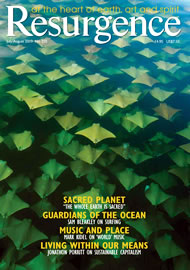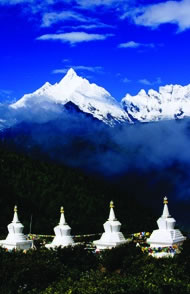The experience of the Earth as sacred was universally shared by diverse human cultures for most of history, until, over the last few hundred years, the modern idea of materialism triumphed. The shared wisdom of the sacredness of life is based on the understanding that the physical world is animated by a spiritual force – an energy or intelligence – which imbues all forms of life and natural features. This intelligent universe has an order, into which humanity is born. This order is sacred, in that it must not be disturbed or violated. It is this order that maintains the integrity of life. Humans need to abide by the law of the universe, which is the source of true law. If we violate this order and its inherent energetic qualities, we suffer at all levels of our being.
Indigenous peoples have been warning those involved in the military-industrial complex that the accumulated effect of constantly breaking spiritual, energetic and ecological laws will lead inevitably to social, economic and ecological chaos. Pre-industrial societies, such as the Mayan civilisation in Central America, which destroyed their ecological foundations also collapsed. The difference now is that the industrial mind, which recognises nothing as sacred, has colonised the Earth. Hence, for the first time in human history, we face multiple planetary-level crises.
Shamans from the Colombian Amazon have been sharing their insights into this crisis with African civil society leaders since 2004. Their message is clear: the level of destruction of the planet is so huge that we need to follow a disciplined path of potency to heal our world. Two essential elements in guiding this path are sacred natural sites and the associated Guardians and Elders, who are able to communicate with the spiritual world and understand these special sites as a network of potent energy points on the body of the Earth. These play a vital ecological and energetic function in maintaining the resilience of the Earth and human communities. It is essential to protect these sacred sites against the growing ravages of commercial and military forces, as their health is a primary condition for some level of recovery from the last few centuries of violation.
Five years on and the leaders of six African countries are rediscovering and working with their Elder knowledge-holders, who have resoundingly similar views to the Amazonian, North American and Russian shamans. These Elders identify that their absolute priority is to revive and protect their sacred natural sites, in order to bring back the traditional social order. They are clear that the deepening “sicknesses” which African communities suffer – from HIV/Aids to youth violence and material poverty – are all consequences of disrespect and violation of traditional norms within their territories, and especially their sacred sites. Chief Tshivhase from Venda, South Africa said, “If the Earth is sick, how can humans be healthy? We are responsible to our ancestors and to the future generations to maintain the health of our territories. Our norms teach us respect for all life. If we lose respect, we lose everything. This is why we are suffering – we feel the pain of the Earth each day, as we witness violence to the Earth and among our people.”
IT IS COMMONLY understood by traditions across the world that ceremonies associated with sacred sites play a central role in energising these places of potency. They bring the community together at key moments in the ecological calendar: the planting season when the first rains come, the harvest season to give thanks, rain-calling ceremonies, and so on. In so doing they maintain the order of the human community in its relationship to the wider Earth Community. Children learn to respect the Earth, her cycles, the knowledge holders, and the roles and relationships in society and with Nature. Respect is understood as a way of being.
Sacred natural sites for most traditional societies are thus at the heart of their ecologically centred governance systems. By reinstating the role and potency of sacred places, order is brought back to both the territory and the human community. This order is the foundation of resilience, which is an essential characteristic especially required at a time of crisis and instability. The role of ecosystems and biodiversity in maintaining the Earth’s climatic, hydrological and energetic equilibrium is one of the central laws that knowledge of sacred sites teaches. These sites are also essential in traditional practices related to climate mediation.
As the breakdown of global economic and trade systems deepens, so the opportunities grow for rethinking and re-ordering the chaos that has been created at every level of human and Earth relations. Cultural historian Thomas Berry foresaw that the collapse of industrial civilisation was imminent and inevitable, as is the case for any society that destroys its life support system. The biggest challenge we face, however, is to shift from an anthropocentric worldview to a more Earth-centred understanding of life. These last few hundred years have removed us from our ecological embeddedness so that we no longer recognise our total dependency on the Earth. Our obsession with human-created ideas, things and places removes us from this reality.
This is why Berry advises us that our two sources of inspiration are the Earth, as the primary giver of life, and Indigenous traditions, which hold the memory of our origins and our role in the web of life. Our challenge is to reconnect with our own Indigenous path – in other words, with our own origins and the inherent laws that govern life in the place where we live. This is the only true reality. When human-created ideas and objects fall away, what is left is the need for meaning, food, warmth and community – both the human and the Earth Community.
THE CRISIS WE face gives us this opportunity – or rather imperative. Now is a time to return to the first principles of life. Let us refer to the perennial wisdom in each of our own traditions, where we will find resonance with other cultures. And, as we are rapidly learning, there are limits to our self-centred hubris, and the Sacred Earth ultimately has the last call. There are non-negotiable limits beyond which we cannot go. Humility, respect and the willingness to learn from universal principles that have outlived the industrial path by multiple centuries are surely the first steps in the journey to finding our way back to an authentic, meaningful, healthy and nonviolent life.
Given the commonly held experience of sacred places as potent energetic centres of governance, learning and transformation within the sacred body of the Earth, we can – with the required attitude of humility, respect and willingness – befriend a sacred place near home and discover what it has to teach us.








